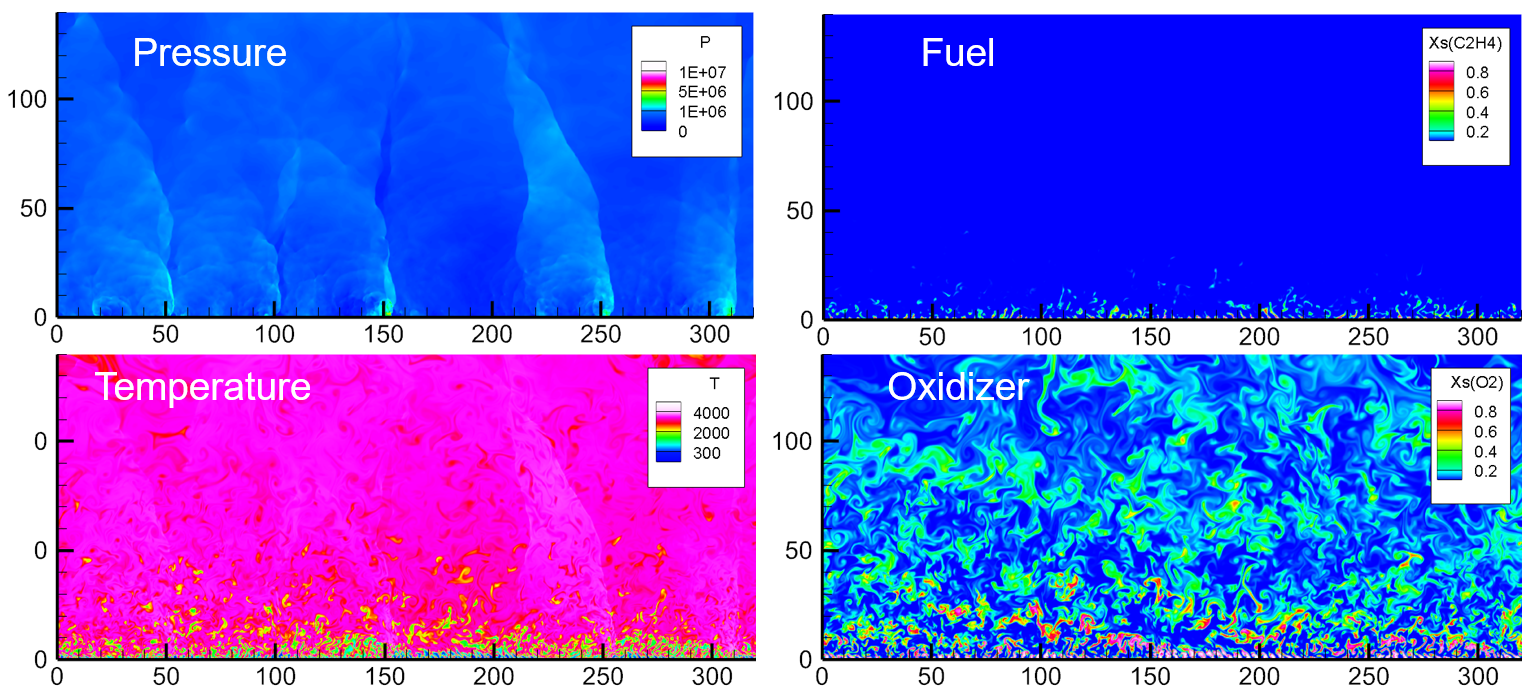Fadamental numerical analysis on detonation propagation
JAXA Supercomputer System Annual Report February 2022-January 2023
Report Number: R22EACA45
Subject Category: JSS Inter-University Research
- Responsible Representative: Toshiharu Mizukaki, Professor, Tokai University
- Contact Information: Toshiharu Mizukaki, Professor, Tokai University(mzkk@tsc.u-tokai.ac.jp)
- Members: Toshiharu Mizukaki, Faming Wang
Abstract
For fundamental study on propagation of detonation waves inside rotating detonatio engines, fundamental numerical analysis using CHARIOT was done. In FY2022, 2D numerical analysis on propagation of detonation waves inside a rotating detonation engine with C2H4/O2 and H2/AIR mixture gases have been calucurated.
Reference URL
N/A
Reasons and benefits of using JAXA Supercomputer System
Even for fundamental numerical analysisi on propagation of detonation waves, huge computational resources and high-performance CPU must be needed due to high-speed propagation and numerous erementaly reactions. JAXA’s JSS3 has enough capability to carry out numerical analysis for detonation research. Therefore, our reserach need to perform the analysis with JSS3.
Achievements of the Year
Two-dimensional numerical analysis of detonation waves propagating in combustible jet trains. (Figures 1 and 2)
Two-dimensional numerical analysis of a rotating detonation engine using ethylene oxygen. (Fig. 3)
Two-dimensional numerical analysis of a rotating detonation engine using hydrogen air. (Fig. 4)

Fig.1: Two-dimensional numerical analysis of detonation waves propagating in combustible jet trains. (Ethylene Oxygen premixed)

Fig.2: Two-dimensional numerical analysis of detonation waves propagating in combustible jet trains.(Ethylene Oxygen non-premixed)
Publications
– Other
Doctor thesis: Experimental and numerical study on propagation of detonation wave in combustible jet train, Faming Wang, Tokai University (2023)
Usage of JSS
Computational Information
- Process Parallelization Methods: MPI
- Thread Parallelization Methods: OpenMP
- Number of Processes: 20 – 100
- Elapsed Time per Case: 217922.4 Second(s)
JSS3 Resources Used
Fraction of Usage in Total Resources*1(%): 0.19
Details
Please refer to System Configuration of JSS3 for the system configuration and major specifications of JSS3.
| System Name | CPU Resources Used(Core x Hours) | Fraction of Usage*2(%) |
|---|---|---|
| TOKI-SORA | 5110736.53 | 0.22 |
| TOKI-ST | 0.83 | 0.00 |
| TOKI-GP | 0.00 | 0.00 |
| TOKI-XM | 0.00 | 0.00 |
| TOKI-LM | 0.00 | 0.00 |
| TOKI-TST | 0.00 | 0.00 |
| TOKI-TGP | 0.00 | 0.00 |
| TOKI-TLM | 0.00 | 0.00 |
| File System Name | Storage Assigned(GiB) | Fraction of Usage*2(%) |
|---|---|---|
| /home | 260.00 | 0.24 |
| /data and /data2 | 5220.00 | 0.04 |
| /ssd | 150.00 | 0.02 |
| Archiver Name | Storage Used(TiB) | Fraction of Usage*2(%) |
|---|---|---|
| J-SPACE | 0.00 | 0.00 |
*1: Fraction of Usage in Total Resources: Weighted average of three resource types (Computing, File System, and Archiver).
*2: Fraction of Usage:Percentage of usage relative to each resource used in one year.
ISV Software Licenses Used
| ISV Software Licenses Used(Hours) | Fraction of Usage*2(%) | |
|---|---|---|
| ISV Software Licenses(Total) | 0.00 | 0.00 |
*2: Fraction of Usage:Percentage of usage relative to each resource used in one year.
JAXA Supercomputer System Annual Report February 2022-January 2023




